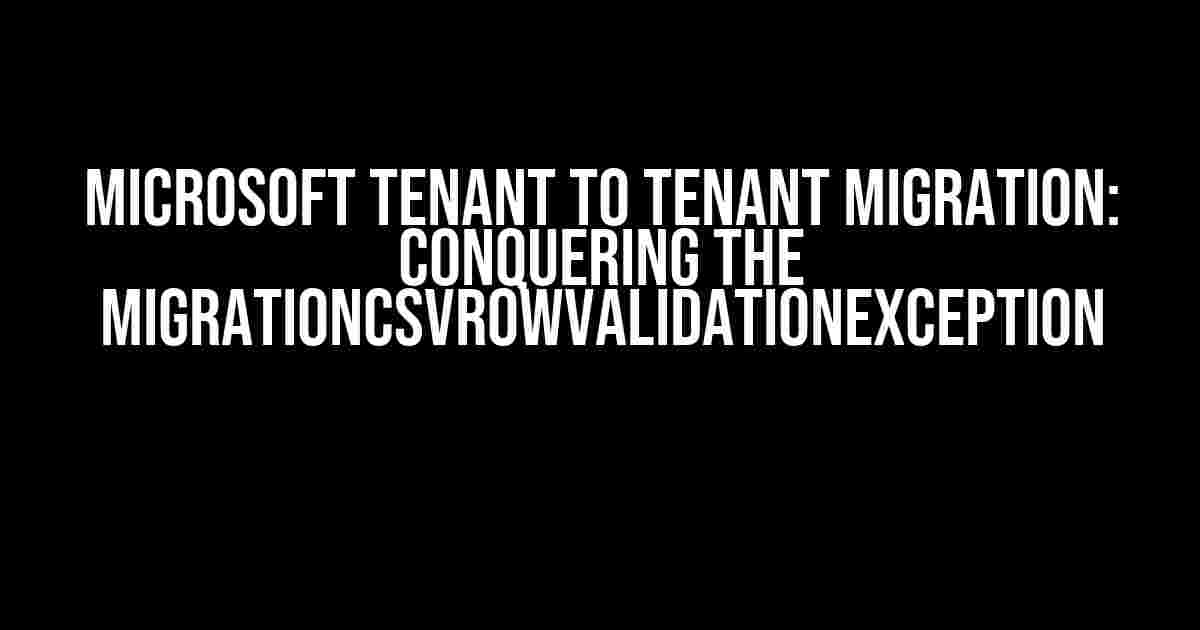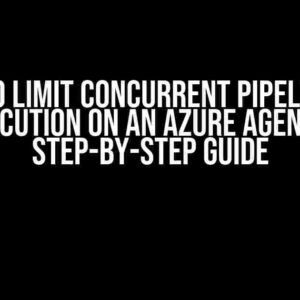migrating from one Microsoft tenant to another can be a daunting task, especially when faced with the cryptic MigrationCSVRowValidationException error. Fear not, dear reader, for we shall embark on a journey to demystify this error and provide you with the knowledge to overcome it.
What is MigrationCSVRowValidationException?
The MigrationCSVRowValidationException error occurs when there is an issue with the CSV file used for the migration. This file contains the necessary information for the migration, such as user details and permissions. When the migration tool encounters an error in the CSV file, it throws this exception, preventing the migration from completing successfully.
Common Causes of MigrationCSVRowValidationException
Invalid CSV file format: The CSV file must be in a specific format for the migration tool to read it correctly. Any deviations from this format can cause the error.Missing or incorrect header columns: The CSV file requires specific header columns, such as “EmailAddress” or “Password”. Omitting or misnaming these columns can trigger the error.Duplicate user entries: If the CSV file contains duplicate user entries, the migration tool will encounter an error.Invalid or malformed data: The data in the CSV file must be accurate and well-formed. Any invalid or malformed data can cause the error.
Step-by-Step Troubleshooting Guide
Follow these steps to identify and resolve the issue causing the MigrationCSVRowValidationException error:
Step 1: Review the CSV File Format
"EmailAddress","Username","Password","FirstName","LastName","JobTitle","Department","Company","Country"
"[email protected]","user1","password123","John","Doe","Software Engineer","IT","Example Inc.","USA"
"[email protected]","user2","password456","Jane","Smith","Marketing Manager","Marketing","Example Inc.","USA"
Verify that the CSV file has the correct format, with each column separated by a comma and each row ending with a newline character. Make sure the header columns are correctly named and in the correct order.
Step 2: Check for Duplicate User Entries
Use a spreadsheet program or a text editor to search for duplicate user entries in the CSV file. Remove any duplicates to ensure each user has a unique entry.
Step 3: Validate User Data
Review the user data in the CSV file to ensure it is accurate and well-formed. Check for:
Invalid email addresses: Verify that each email address is correctly formatted and does not contain any typos.Missing or incorrect passwords: Ensure that each user has a valid password, meeting the required password policy.Incorrect or missing user information: Verify that each user’s information, such as first name, last name, and job title, is accurate and complete.
Step 4: Validate Header Columns
Verify that the header columns are correctly named and in the correct order. Compare your CSV file headers with the required headers for the migration tool.
| Header Column | Required? | Description |
|---|---|---|
| EmailAddress | Yes | The user’s email address. |
| Username | Yes | The user’s username. |
| Password | Yes | The user’s password. |
| FirstName | No | The user’s first name. |
| LastName | No | The user’s last name. |
Step 5: Test the CSV File
After making changes to the CSV file, test it by running the migration tool again. If the error persists, repeat the troubleshooting steps to identify the root cause.
Best Practices for Avoiding MigrationCSVRowValidationException
To minimize the risk of encountering the MigrationCSVRowValidationException error, follow these best practices:
Create a clean and accurate CSV file: Ensure the CSV file is free from errors and contains accurate user data.Use a consistent CSV file format: Stick to a consistent CSV file format throughout the migration process.Validate user data before migration: Verify user data before starting the migration to avoid any potential issues.Test the CSV file before migration: Test the CSV file with a small sample of users to ensure it works correctly.
Conclusion
The MigrationCSVRowValidationException error can be a frustrating obstacle in the Microsoft tenant to tenant migration process. However, by following the steps outlined in this article, you can identify and resolve the underlying issues, ensuring a successful migration.
Remember, a well-formed CSV file is key to a successful migration. Take the time to review and validate your CSV file to avoid encountering this error.
With these troubleshooting steps and best practices, you’ll be well-equipped to overcome the MigrationCSVRowValidationException error and complete your Microsoft tenant to tenant migration with confidence.
Frequently Asked Question
Get the answers to your burning questions about Microsoft tenant to tenant migration and the pesky MigrationCSVRowValidationException error!
What is MigrationCSVRowValidationException error?
The MigrationCSVRowValidationException error occurs when there’s an issue with the CSV file used for the migration. This could be due to incorrect formatting, invalid characters, or missing required columns. It’s like trying to put a square peg into a round hole – it just won’t fit!
What are the common causes of MigrationCSVRowValidationException error?
Some common culprits behind this error include incorrect or missing header rows, incorrect data types, and mismatched column counts. It’s like trying to build a puzzle with missing pieces – it’s gonna be a puzzle to fix!
How can I resolve the MigrationCSVRowValidationException error?
To resolve this error, review your CSV file, check the formatting, and ensure all required columns are present. You can also try re-exporting the CSV file or using a different migration tool. Think of it like debugging a code – you gotta check line by line to find the issue!
Can I prevent MigrationCSVRowValidationException error from occurring?
Yes, you can prevent this error by carefully reviewing your CSV file before migration, using a template to ensure correct formatting, and testing a small sample of data before migrating everything. It’s like proofreading an essay – you gotta check for mistakes before submitting!
What are some best practices for Microsoft tenant to tenant migration?
Some best practices include planning carefully, using the right migration tools, testing thoroughly, and having a rollback plan in place. It’s like moving to a new house – you gotta have a solid plan to make it smooth and stress-free!



